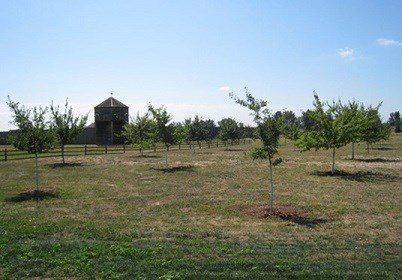Last updated: March 9, 2023
Article
Restoring Resources: Prairie Restoration Project
Fort Vancouver National Historic Site (FOVA) is rich with history and culture. Stewarded for centuries by Native tribes, the site is still connected to over thirty tribes as well as Native Hawaiians. In 1824, Fort Vancouver was established as the western headquarters for the British fur trading business, Hudson’s Bay Company. The convergence of the nearby Willamette and Columbia rivers allowed for easy trade access, and the sloping plains were ideal for agriculture. For the next several decades, Hudson’s Bay Company occupied the site until a gradual transition to the US Army. The site ultimately transformed into a headquarters and military base for the Army by 1860. The Fort was later designated a National Monument by the National Park Service in 1948 and a National Historic Site in 1966.

NPS Gallery *Images credited to NPS without any copyright symbol are public domain
As part of my fellowship fieldwork and Public Land Corps hours, I had the honor of being able to contribute to the prairie restoration project. My main tasks were to identify historic land management practices, research prescribed-burn alternatives, and compile a native plant index. My research included reviewing available scientific articles, local reports, and interviewing experts from other parks and organizations (such as the US. Forest Service). The park’s next steps include a tribal summit and launching an interdisciplinary team to draft the restoration plan.

NPS Gallery *Images credited to NPS without any copyright symbol are public domain
Many iconic Pacific Northwest species, such as the ponderosa pine (Pinus ponderosa) and camas (Camassia quamash) are fire-adapted species, meaning they thrive under disturbance. While many people envision horrific scenes of damage and death when they think of fire, wildfires have historically maintained ecological balance for millennia, helping to create equilibrium across the needs of diverse species. Prescribed burning is the ideal solution for prairie restoration efforts. However, the park’s proximity to major thoroughfares and an operational airfield may create barriers to implementation. Therefore, my research largely focused on prescribed burn alternatives such as mowing.
Having an interest in conservation, this project really spoke to me. I truly appreciate the opportunity to contribute to a project that is actively working towards protecting and restoring natural and cultural resources while actively involving local tribes in the process. Restoring even a small part of the natural prairie ecosystem at FOVA will re-establish habitat and food sources for endangered plants, birds, and mammals, provide educational opportunities for visitors, and supplement cultural resources for Native tribes in the region.
Article written by Audrey Nelson
for "A Day in the Life of a Fellow" Article Series
National Park Service - Workforce Management Fellow
in Partnership with Northwest Youth Corps (NYC)
Tags
- fort vancouver national historic site
- fellowships
- internships
- find your park
- fort vancouver
- hudson bay company
- native plants
- restoration
- restoration project
- indigenous knowledge
- indigenous people
- fire
- conservation
- cultural resources
- cultural resources and fire management
- prescribed burn
- invasive plant species
